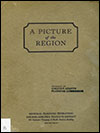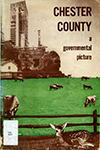Archived Publications
The publications featured on this webpage are outdated and some were printed and digitized for online viewing.
Chester County Migration Flows, 2006-2010
Presents data on population movement between Chester County and other counties in the U.S. The total migration flows include in-migration and out-migration during the time period 2006 to 2010. View Report
 A Picture of the Region
A Picture of the Region
By the Regional Planning Federation of the Philadelphia Tri-State District
Publication year not identified: maps dated 1926; population charts refer to 1920 census
Not copyrighted
This report is a fascinating look back at the early days of planning. The need for regional planning is emphasized along with supporting facts, charts, and maps from the 1870s to 1926. Some of the concerns at that time period are described:
- Building roads "is no longer a matter of blazing and clearing a way through the wilderness."
- The population distribution from 1900 to 1920 was leaving the country and concentrating in cities.
- "More than half of the communities of the region have no public parks and playgrounds"
- Many streams in the region were inexcusably polluted by sewage and industrial waste.
- "Zoning has been less accepted in the tri-state district than in any other great metropolitan area in the country. Eight or 10 communities in this region have adopted this principle."
 Chester County, a Governmental Picture
Chester County, a Governmental Picture
By the Commissioners of Chester County, 1959
The Commissioners of Chester County prepared this guidebook to help citizens understand county government and the roles of county officers, departments, services, and facilities. A brief history begins with William Penn's naming of the county in 1682, then highlights key events and locations through the centuries—providing a foundation for Chester County's continued growth.This report is written in an easy to understand format and is peppered with photographs and charming illustrations. View Publication
 Chester County Planning Commission Interim Plan 1974
Chester County Planning Commission Interim Plan 1974
By the Chester County Planning Commission, 1974
This 1974 comprehensive plan is composed of detailed background studies and "the plan." The plan is organized into three parts:
- Alternate strategies and patterns of development are presented in detail: growth, no-growth; corridors; sprawl; urban centers; and megacity.
- The Transportation Plan
- The Land Use Plan including large detailed color pull-out maps
 Chester County in the Year 2000: the County of the Future
Chester County in the Year 2000: the County of the Future
By Earl M. Baker, Chairman, Chester County Commissioners, 1984
Commissioner Baker presented facts, problems of the past and present-day 1984, and ways to meet the challenges of the future. This report looks back 100 years from the 1880s to 1984, describes our wonderful county, and states that action is needed by individuals and communities to protect the future of the county. Noting that a great amount of development is ready to occur, issues are organized under eight facts:
- Over 10,000 lots approved for development in central and eastern Chester County
- 87% of workers drive in a private car
- 5 acres per day of agricultural land lost to development
- 1,000 tons of trash generated per day
- More than 2/3 residents depend on water sources within the county
- Farmland eroding 3-8 tons of soil per year
- High population growth; elderly the fastest
- High employment increase— 36% from 1970 to 1980
"It is a challenge we all share. Let us accept it for ourselves and make it our purpose to help others understand at every opportunity that we have a common set of challenges and choices." View Publication
Chester County Community Design Guide Series
The Community Design Guide Series consists of three documents created to support Landscapes, the 1996 Chester County Comprehensive Plan, and guide municipal level efforts to preserve and enhance important character-defining features.
Village Planning Handbook (1993)
This Handbook offers a unique approach to looking at villages - from the context of Chester County, Rather than merely offering an inventory of existing villages, the Handbook provides the reader with a process by which existing villages can be conserved and even new villages created within the planning process under Pennsylvania law. View Publication

